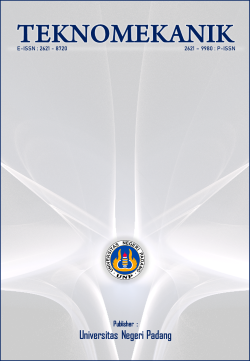Blended model of distance learning: Does it effective?
DOI:
https://doi.org/10.24036/jptk.v3i4.15223Keywords:
distance learning, blended learning, mixed learming, student learning outcomes, students' perceptionsAbstract
This study aims to determine whether distance learning is effective to implement. This study compares the blended model of distance learning with traditional learning. What is being compared is student learning outcomes and their perceptions in these two lessons. This research is a quantitative study using a quasi-experimental research design with a time-series model. The population of this research is all 4th-semester students who take Digital Electronics courses. Data collection was carried out in two ways, namely by using several tests for data on learning outcomes and questionnaires for student perception data. Data analysis was made using the t-test for paired samples. The results of the analysis obtained that there are differences in the two samples tested mean and the distance learning blended model has a higher average than traditional learning. This shows that the blended model of distance learning is more effective than traditional learning.
Downloads
References
Alsalhi, N. R., Eltahir, M. E., & Al-Qatawneh, S. S. (2019). The effect of blended learning on the achievement of ninth grade students in science and their attitudes towards its use. Heliyon. https://doi.org/10.1016/j.heliyon.2019.e02424
Bruno, F. (2002). Psychology: A Self-Teaching Guide. John Wiley & Sons, Inc.
Finkelstein, J. (2006). Learning in real time: Synchronous teaching and learning online. In Learning in real time: Synchronous teaching and learning online.
Graham, C. R. (2006). Blended learning systems: Definition, current trends, and future directions. In Handbook of blended learning: Global perspectives, local designs.
Harahap, F., Nasution, N. E. A., & Manurung, B. (2019). The effect of blended learning on student’s learning achievement and science process skills in plant tissue culture course. International Journal of Instruction. https://doi.org/10.29333/iji.2019.12134a
Jansen. (n.d.). Dosen Fatek Unima Kembangkan Blended Learning. Retrieved November 7, 2020, from http://www.komentar.co.id/2019/09/dosen-fatek-unima-kembangkan-blanded.html
Kadir. (2016). Statistik Terapan: Konsep, Contoh dan Analisa Data dengan Program SPSS/ Lisrel dalam Penelitian (2nd ed.). Rajawali Pers.
Kementerian Pendidikan dan Kebudayaan » Republik Indonesia. (n.d.). Retrieved November 7, 2020, from https://www.kemdikbud.go.id/main/blog/2020/05/kemendikbud-terbitkan-pedoman-penyelenggaraan-belajar-dari-rumah
Kim, W. (2007). Towards a Definition and Methodology for Blended Learning. In J. Fong (Ed.), Blended Learning (pp. 1–8). City University of Hongkong.
Kintu, M. J., Zhu, C., & Kagambe, E. (2017). Blended learning effectiveness: the relationship between student characteristics, design features and outcomes. International Journal of Educational Technology in Higher Education. https://doi.org/10.1186/s41239-017-0043-4
Kiviniemi, M. T. (2014). Effects of a blended learning approach on student outcomes in a graduate-level public health course. BMC Medical Education. https://doi.org/10.1186/1472-6920-14-47
Kurt, S., & Yıldırım, İ. (2018). The Students’ Perceptions on Blended Learning: A Q Method Analysis. EDUCATIONAL SCIENCES: THEORY & PRACTICE, 18(2), 427–446. https://doi.org/10.12738/estp.2018.2.0002
Littlejohn, A., & Pegler, C. (2007). Preparing for blended e-Learning. In Preparing for Blended e-Learning. https://doi.org/10.4324/9780203961322
LMS Amelia Unima. (n.d.). https://amelia.unima.ac.id/
Matthen, M. (2015). The Oxford Handbook of Phylosophy of Perception (M. Matthen (Ed.); 1st ed.). Oxford University Press.
Miftah, M. (2013). Fungsi, dan peran media pembelajaran sebagai upaya peningkatan kemampuan belajar siswa. Jurnal Kwangsan. https://doi.org/10.31800/jurnalkwangsan.v1i2.7
Oakley, G. (Faculty of E. U. of W. A. (2016). Blended Learning for Quality Higher Education: Selected Case Studies on Implementation from Asia-Pacific. In C. P. Lim & L. Wang (Eds.), From Diffusion to Explosion: Accelerating Blended Learning at the University of Western Australia (pp. 67–102). UNESCO. https://www.researchgate.net/publication/311806838
Öhrstedt, M., & Lindfors, P. (2019). First-semester students’ capacity to predict academic achievement as related to approaches to learning. Journal of Further and Higher Education. https://doi.org/10.1080/0309877X.2018.1490950
Papadopoulos, T. C., Parrila, R. K., & Kirby, J. R. (2015). Cognition, Intelligence, and Achievement. In Cognition, Intelligence, and Achievement. https://doi.org/10.1016/b978-0-12-410388-7.00001-4
Rahman, A., & Ilic, V. (2019). Blended Learning in Engineering Education: Recent Developments in Curriculum, Assessment and Practice (1st ed.). CRC Press.
Ratnawulan, E., & Rusdiana, H. A. (2014). Evaluasi Pembelajaran: Dengan Pendekatan Kurikulum 2013. In Pustaka Setia.
Shadish, W. R., Cook, T. D., & Campbell, D. T. (2002). Experimental and Quasi-Experimental Designs for Generalized Causal Inference. Boston: Houghton Mifflin. In Experimental and QuasiExperimental Designs for Generalized Causal Inference.
Shahabadi, M. M., & Uplane, M. (2015). Synchronous and Asynchronous e-learning Styles and Academic Performance of e-learners. Procedia - Social and Behavioral Sciences. https://doi.org/10.1016/j.sbspro.2015.01.453
Sugiyono. (2014). Metode Penelitian Pendidikan pendekatan Kuantitatif, Kualitatif dan R&D. In METODE PENELITIAN ILMIAH.
Sugiyono. (2015). Statistik untuk Penelitian. Alfabeta.
Wang, N., Chen, J., Tai, M., & Zhang, J. (2019). Blended learning for Chinese university EFL learners: learning environment and learner perceptions. Computer Assisted Language Learning. https://doi.org/10.1080/09588221.2019.1607881
Watson, J. (2008). Blended Learning : The Convergence of Online and Face-to-Face Education. North American Council for Online Learning.
Wright, B. M. (2017). Blended learnings student perception of face-to-face and online EFL lessons. Indonesian Journal of Applied Linguistics. https://doi.org/10.17509/ijal.v7i1.6859
Downloads
Published
Issue
Section
License
Copyright (c) 2021 Calvin Johanes Mamahit

This work is licensed under a Creative Commons Attribution 4.0 International License.





